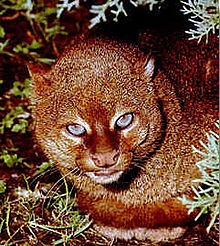Gulf Coast jaguarundi
| Gulf Coast Jaguarundi[1] | |
|---|---|

| |
| Scientific classification | |
| Kingdom: | |
| Phylum: | |
| Class: | |
| Order: | |
| Family: | |
| Genus: | |
| Species: | |
| Subspecies: | P. y. cacomitli
|
| Trinomial name | |
| Puma yagouaroundi cacomitli (Berlandier, 1859)
| |
| Synonyms | |
| |
The Gulf Coast Jaguarundi (Puma yagouaroundi cacomitli) is a subspecies of Jaguarundi that ranges from southern Texas in the United States south to Veracruz and San Luis Potosí in eastern Mexico.[3] This cat looks like a large weasel or otter with a coat in one one three color phases: black, reddish-brown or brownish-gray.[4] Darker varieties tend to be found in darker places, like forests, than those who are lighter in hue, which prefer more open areas.[5]
Habitat
The Gulf Coast Jaguarundi can be found in the Western Gulf coastal grasslands, Tamaulipan mezquital, and Tamaulipan matorral.[6] Its preferred habitat are regions of dense, thorny scrub, especially near water,[3] composed of plants such as Spiny Hackberry (Celtis pallida), Brazilian Bluewood (Condalia hookeri), Desert Yaupon (Schaefferia cuneifolia), Berlandier's Wolfberry (Lycium berlandieri), Lotebush (Ziziphus obtusifolia), Texas Goatbush (Castela erecta), Whitebrush (Aloysia gratissima), Catclaw Acacia (Acacia greggii), Blackbrush Acacia (Acacia rigidula), Velvetleaf Lantana (Lantana velutina), Texas Lignum-vitae (Guaiacum angustifolium), Cenizo (Leucophyllum frutescens), Elbowbush (Forestiera pubescens), and Texas Persimmon (Diospyros texana).[4]
Threats
Recently, it has been suggested by some environmentalists that the Jaguarundi, and many other fauna unique to Southern Texas, will be severely threatened if a proposed 16 foot wall is constructed along segments of the Mexico–United States border.[7]
References
- ^ Wozencraft, W. C. (2005). "Order Carnivora". In Wilson, D. E.; Reeder, D. M. (eds.). Mammal Species of the World: A Taxonomic and Geographic Reference (3rd ed.). Johns Hopkins University Press. p. 545. ISBN 978-0-8018-8221-0. OCLC 62265494.
- ^ Template:IUCN2006
- ^ a b "Puma yagouaroundi cacomitli". NatureServe Explorer. NatureServe. Retrieved 2009-01-01.
- ^ a b "Jaguarundi" (PDF). Texas Parks and Wildlife Department. Retrieved 2008-12-31.
- ^ "Gulf Coast jaguarundi (Herpailurus (=Felis) yagouaroundi cacomitli)". Environmental Conservation Online System. United States Fish and Wildlife Service. Retrieved 2008-12-31.
- ^ "Fauna Silvestre Presente en el Estado de Nuevo Leon" (PDF) (in Spanish). Secretariat of the Environment and Natural Resources. Retrieved 2009-01-01.
{{cite web}}: CS1 maint: unrecognized language (link) [dead link] - ^ Bustillo, Miguel (17 October 2007). "Wildlife at border may lose sanctuary". Los Angeles Times.
External links
![]() Media related to Puma yagouaroundi cacomitli at Wikimedia Commons
Media related to Puma yagouaroundi cacomitli at Wikimedia Commons
![]() Data related to Puma yagouaroundi cacomitli at Wikispecies
Data related to Puma yagouaroundi cacomitli at Wikispecies

